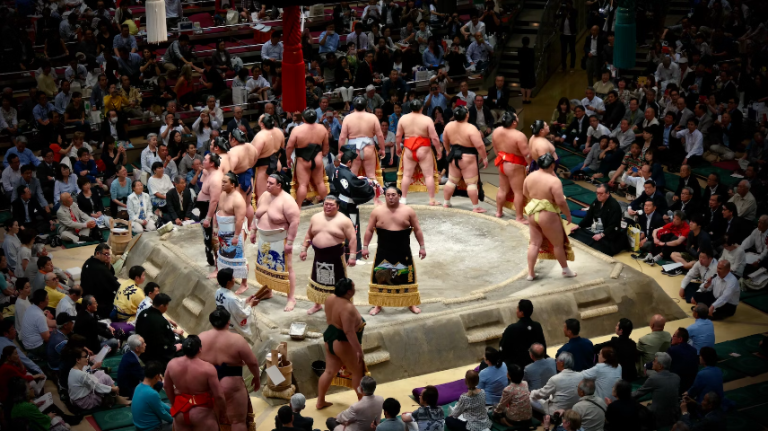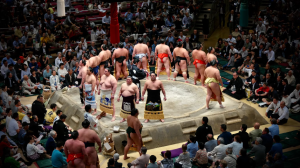Sumo, Japan’s ancient and revered national sport, is a mesmerizing spectacle that combines incredible physical prowess with deep-rooted traditions and rituals. In this article, we delve into the rituals and traditions of sumo tournaments, exploring the rich cultural heritage that accompanies this unique sport.
The Ring of Tradition: The Sumo Dohyo
At the heart of every sumo tournament lies the dohyo, the elevated ring where matches take place. The construction of the dohyo is a meticulously choreographed ritual in itself, symbolizing the sacredness and purity of the sport. Prior to each tournament, the dohyo is built using a combination of clay, sand, and other natural materials. The process is overseen by a Shinto priest who performs a purification ceremony to sanctify the ring. This ritual ensures that the dohyo becomes a sacred space where the wrestlers can demonstrate their strength and honor the traditions of sumo.
The dohyo is a perfect circle measuring 4.55 meters in diameter and is surrounded by a ridge made of tightly packed straw bales called “tawara.” These bales serve both as a physical boundary for the wrestlers and as a symbolic representation of the original straw ring used in ancient times. Stepping out of the ring during a match, known as “dohyo-iri,” results in an immediate loss for the wrestler. The dohyo’s circular shape and the strict rules associated with it embody the principles of balance, discipline, and respect that are central to the sport of sumo.
The Ceremonial Entry: Dohyo-iri and Yokozuna Deliberations
Before each day of competition, the wrestlers partake in a solemn ritual known as dohyo-iri, during which they make a ceremonial entry into the dohyo. Dressed in traditional silk aprons, the wrestlers perform a series of intricate movements, paying homage to the sport, the spectators, and the gods. Each sumo stable has its unique dohyo-iri style, which is passed down through generations, preserving the distinct heritage of the stables.
One of the most highly anticipated moments of a sumo tournament is the yokozuna deliberation ceremony. Yokozuna, the highest rank in sumo, is reserved for the most accomplished and revered wrestlers. The deliberation ceremony takes place in the presence of the Yokozuna Deliberation Council, a panel of retired yokozuna and sumo elders. The aspiring yokozuna performs a series of ritualistic movements and displays his strength, technique, and composure. The council evaluates the wrestler’s performance and decides whether to grant him the prestigious rank of yokozuna. This ceremony is a testament to the honor and prestige associated with reaching the pinnacle of sumo.
Table. Sumo Tournament Rituals and Traditions
| Rituals and Traditions | Explanation |
|---|---|
| Dohyo Construction | The meticulous construction of the dohyo, the sumo ring, using natural materials and the purification ceremony performed by a priest |
| Dohyo-iri | The ceremonial entry of the wrestlers into the dohyo, performed before each day of competition, paying homage to the sport and spectators |
| Yokozuna Deliberations | The evaluation ceremony where aspiring yokozuna display their skills and composure in front of the Yokozuna Deliberation Council |
The Symbolic Attire: Mawashi and Kesho-mawashi
The attire worn by sumo wrestlers is steeped in symbolism and tradition. The most recognizable element is the mawashi,a loincloth made of silk or cotton. The mawashi serves both practical and symbolic purposes. It provides support to the wrestlers during matches, allowing them to showcase their strength and technique. Symbolically, the mawashi represents the purity and simplicity of sumo, as it is the only garment worn by the wrestlers in the ring.
In addition to the mawashi, wrestlers adorn themselves with intricately embroidered aprons called kesho-mawashi. These aprons are works of art, often sponsored by local businesses or fans. They feature vibrant colors, elaborate designs, and the wrestler’s name and rank. The kesho-mawashi is a symbol of honor and prestige, and its presentation to the wrestler is a moment of great significance.
During the dohyo-iri ceremony, the wrestlers wear even more elaborate kesho-mawashi, which are heavier and more ornate. These ceremonial aprons are a visual representation of the wrestler’s achievements and status in the sport. They are meticulously folded and unfolded by attendants, highlighting the reverence and respect accorded to the wrestlers.
The Rhythmic Ceremonies: Shiko and Salt Tossing
Sumo tournaments are filled with rhythmic and symbolic rituals that add to the sense of spectacle and anticipation. Two such rituals are shiko and salt tossing.
Shiko is a series of leg-stretching exercises performed by the wrestlers before each match. The wrestlers raise their legs high and stomp them down forcefully, creating a distinct sound that reverberates throughout the arena. Shiko not only helps the wrestlers warm up and prepare their muscles but also serves as a display of power and intimidation. The synchronized movements and thunderous stomps create an electrifying atmosphere, captivating the audience.
Salt tossing is another iconic ritual that takes place before each match. The wrestlers scoop a handful of salt from a wooden container called a “sagari” and toss it into the ring. This act is believed to purify the dohyo and ward off evil spirits. The salt is also a symbol of purification and protection for the wrestlers themselves. The precise manner in which the salt is tossed varies from wrestler to wrestler, adding a personal touch to the ritual.
In sum, sumo tournaments are a captivating blend of physicality, tradition, and spirituality. The rituals and traditions surrounding these tournaments form an essential part of the sport’s cultural heritage. From the construction and sanctification of the dohyo to the ceremonial entries, deliberations, attire, and rhythmic ceremonies, each aspect of sumo tournaments reflects the values of discipline, respect, and honor. These rituals provide a glimpse into the rich tapestry of sumo’s ancient traditions and add depth and meaning to the thrilling matches that unfold within the sacred dohyo. Sumo tournaments are not just sporting events but cultural spectacles that continue to enthrall audiences with their unique blend of athleticism and profound symbolism.






+ There are no comments
Add yours